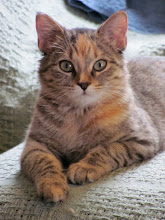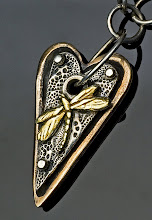
A water-etched pendant with a slide bail on the back. The pattern is based on an upholstery fabric called 'Small Dot', designed by Ray and Charles Eames in 1947.

A sort of Tim Burton-esque piece.

This one reminds me of the kelp forests of Monterey Bay in California.
I got home from Bead and Button on Sunday, and I'm having a bit of trouble getting back into the swing of things. The week was so great, but man, did it tire me out! I hadn't done any work until tonight, when I taught a water-etching on PMC class at
Bead Haven. I like this technique. It's one of those "How did you do that?" techniques. Those are always fun. In water-etching you roll out a piece of metal clay thicker than normal, dry it completely, and paint a design on it with wax. Once the wax is dry, clay from the unwaxed potion of the piece is etched away, creating a fairly deep relief. Once it's fired, you're left with a really unique piece. I remember taking a pottery class in college where we did a very similar technique on bone dry, unfired ceramics. The only difference was that the etching was done with a fine spray of water instead of sponges or baby wipes as we use with PMC etching. It a great technique in it's self, but it also creates a nice surface for enamels or resin. To learn more about water etching, check out a great article by Catherine Davies Paetz in the September 2006 issue of Art Jewelry.




















5 comments:
Love this, a great way to get original textures!
I think so too, Karen. And such a fun way to get your fingers messy!
These look great!!
Does it 'freak you out' that you are losing all that silver clay in the sponges when you do it? I'm a new metal clay addict and the cost of it makes me fear water etching. BUT the idea of water etching is very cool.
Clougee,
No it doesn't because I rinse the sponges or wipes in a bowl of water. When the water evaporates I scrape out the metal clay residue and add it to the slip jar. Waste not, want not!
Post a Comment